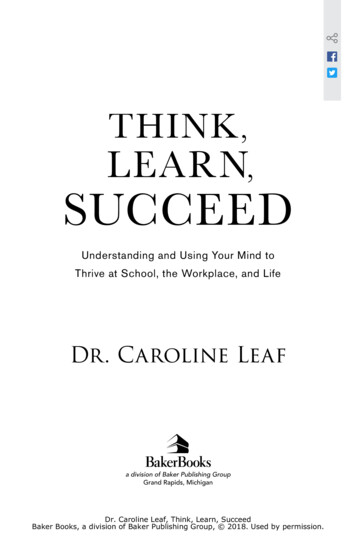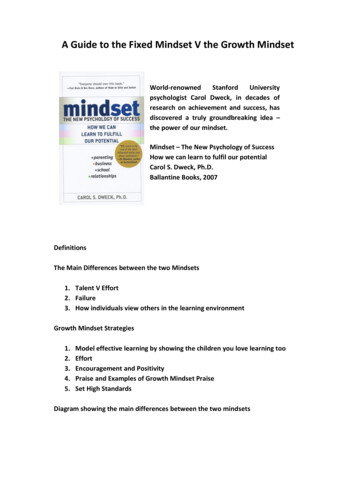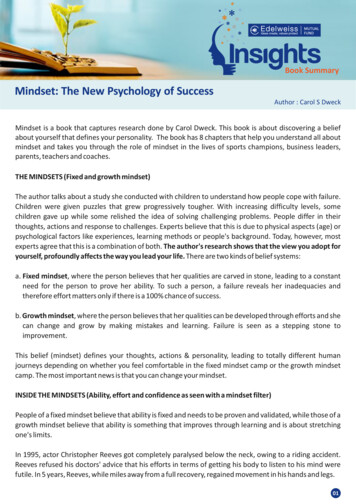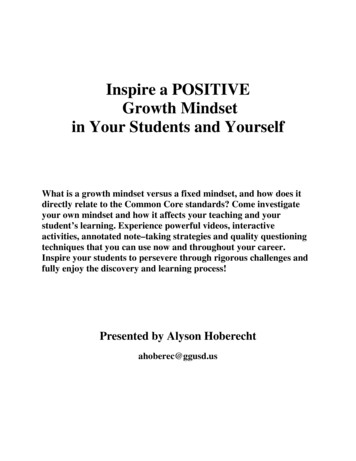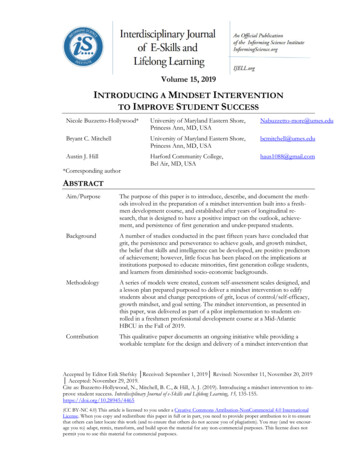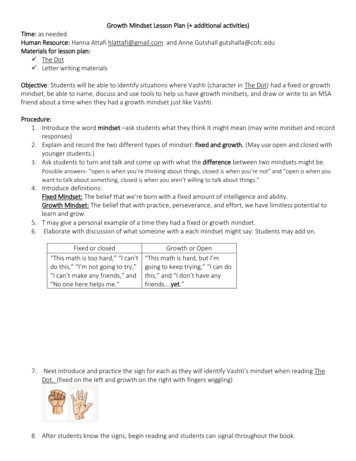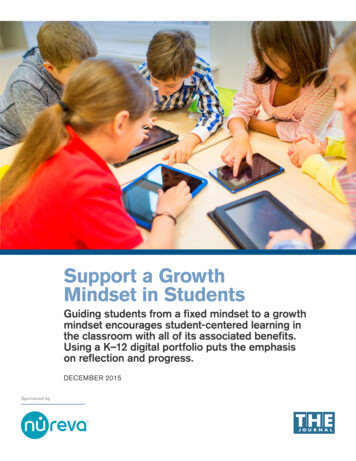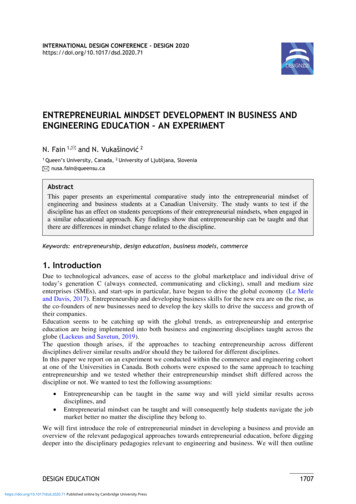
Transcription
INTERNATIONAL DESIGN CONFERENCE – DESIGN RIAL MINDSET DEVELOPMENT IN BUSINESS ANDENGINEERING EDUCATION – AN EXPERIMENTN. Fain 1, and N. Vukašinović 21 Queen’sUniversity, Canada, 2 University of Ljubljana, Slovenianusa.fain@queensu.caAbstractThis paper presents an experimental comparative study into the entrepreneurial mindset ofengineering and business students at a Canadian University. The study wants to test if thediscipline has an effect on students perceptions of their entrepreneurial mindsets, when engaged ina similar educational approach. Key findings show that entrepreneurship can be taught and thatthere are differences in mindset change related to the discipline.Keywords: entrepreneurship, design education, business models, commerce1. IntroductionDue to technological advances, ease of access to the global marketplace and individual drive oftoday’s generation C (always connected, communicating and clicking), small and medium sizeenterprises (SMEs), and start-ups in particular, have begun to drive the global economy (Le Merleand Davis, 2017). Entrepreneurship and developing business skills for the new era are on the rise, asthe co-founders of new businesses need to develop the key skills to drive the success and growth oftheir companies.Education seems to be catching up with the global trends, as entrepreneurship and enterpriseeducation are being implemented into both business and engineering disciplines taught across theglobe (Lackeus and Savetun, 2019).The question though arises, if the approaches to teaching entrepreneurship across differentdisciplines deliver similar results and/or should they be tailored for different disciplines.In this paper we report on an experiment we conducted within the commerce and engineering cohortat one of the Universities in Canada. Both cohorts were exposed to the same approach to teachingentrepreneurship and we tested whether their entrepreneurship mindset shift differed across thediscipline or not. We wanted to test the following assumptions: Entrepreneurship can be taught in the same way and will yield similar results acrossdisciplines, and Entrepreneurial mindset can be taught and will consequently help students navigate the jobmarket better no matter the discipline they belong to.We will first introduce the role of entrepreneurial mindset in developing a business and provide anoverview of the relevant pedagogical approaches towards entrepreneurial education, before diggingdeeper into the disciplinary pedagogies relevant to engineering and business. We will then outlineDESIGN EDUCATIONhttps://doi.org/10.1017/dsd.2020.71 Published online by Cambridge University Press1707
the experiment and the methodology used to test the entrepreneurial mindset across the twodisciplines and present the key findings. Our contribution to the body of knowledge on enterpriseeducation within engineering and business concludes this paper.2. Theoretical contextTo position the experiment appropriately, this paper will first look at the different pedagogicalapproaches to teaching business and engineering, and then look deeper into the key entrepreneurialmindset traits and their relevance within both disciplines.2.1. Engineering pedagogiesThere is a variety of skills that the engineers need to possess prior to entering the job market. Thetacit knowledge related to how things work, how they can be build and what the relationshipsbetween constructs are seem to be key in developing a competent engineer (Zavbi and Vukasinovic,2014). Next to the technical skills and engineering science that forms the backbone of engineeringeducation, research has shown that engineers also need a variety of softer competences, including:(1) design capability, such as intelligence, imagination, creativeness, inventiveness, artfulness,technicality, pragmatism and productiveness, (2) design attitude, including the way of thinkingabout practical creativeness, motivation and inspiration of creating useful things, enjoyment ofinventing artefacts and mind set related to materialization and realization, (3) design knowledge,gained through lectures, industrial case studies, projects and self-management, (4) design skills,such as multi-disciplinary cooperation, application of research and design methods, communicationand exchange of technical information, analysis of complex design problems and task allocation,combining creative capacities with system development capacities, project management, andprototyping and testing, and (5) design experience, or the familiarity gained from seeing and doingthings in the course of acting as a designer, and the obtained feelings and reflections related todesigning and designs (van Doorn et al., 2008).Project based learning has evolved as the dominant pedagogy to teach engineering design, as it isbelieved to offer both engineering science knowledge, as well as collaboration and team working skills(Zavbi and Vukasinovic, 2014; Dym et al., 2005). It presents an opportunity for students to gain therelevant engineering skills through interdisciplinary learning within a wider business or industrycontext. Mills and Treagust, (2003) suggest that this provides students with a wider understanding ofthe applicability of their engineering skills and knowledge.2.2. Business pedagogiesUnlike engineering education, where engineering science plays a key role in developing the relevantskillset, business education often relies on developing the softer set of skills relevant within thebusiness environment. Business pedagogies are often considered pedagogies of uncertainty, as theenvironment they teach about and for, is ever changing and continuously adapting to the newindustrial/business trends. As defined by Shulman (2005) teaching and learning in business ischaracterized by the absence of routine in the discipline as such – it is an ever-changing practice,jumping from structured to creative approaches of doing things in extremely short periods of time,based predominantly on a critical review and analysis of what is happening in the business andsocial environment. Add technology to the mix and the before mentioned generation C is faced withcontinuous adaptation to the way they engage with their environments, which consequentlyinfluences how they approach learning and embracing their work environments as well (Le Merleand Davis, 2017).Different approaches in practice and an ever-changing environment therefore demand differentapproaches in pedagogy. What the students need to learn, understand and acquire is not only theconcepts relevant to the practice of business, but also the skills relevant to dealing with constantchange in their social, political, technical and economic environments. The business, and inparticular entrepreneurship discipline values insights generated from the variety of differentparadigmatic positions to be found in the discipline (Shankar, 2009), and therefore students need to1708https://doi.org/10.1017/dsd.2020.71 Published online by Cambridge University PressDESIGN EDUCATION
embrace and understand these positions to be able to become part of the communities of practice intheir professional lives. At the same time, they are actively changing the discipline through theirengagement with the digital world, where influencers are often the drivers of change and needs thatgeneration C now exhibits.2.3. Entrepreneurial mindsetBeing entrepreneurial is positioned differently within disciplines. Popular belief has it that onecannot be taught how to be an entrepreneur and that one simply needs to be born with it. Researchhas disproved such myths, but there is still disagreement among academia what entrepreneurshipeducation needs to be. Two schools of thought position the educational responsibility either at (1)teaching the students the process of starting up ventures, or (2) teaching them the mindset requiredto be entrepreneurial, such as creativity, teamwork and risk management (Lackeus and Savetun,2019). As can be seen from the disciplinary discussion above, the second school of thought seems toapply both to engineering and business education. Engineers need to develop their designerlycompetences, including creativity, teamwork and problem solving (van Doorn et al., 2008). On theother hand, the business discipline is already based on the softer skills, acknowledged as relevant indeveloping an entrepreneurial mindset. For the purposes of this paper, we therefore define theentrepreneurial mindset in line with the second school of thought, basing the mindset on thedevelopment of key competences, such as creativity, problem-solving, risk mitigation andcooperation. We position the entrepreneurial mindset traits in line with Spinelli and Adams (2016)proposition, thus they include commitment and determination, courage, opportunity obsession,creativity and self-reliance, motivation to excel and leadership.These traits enable entrepreneurs to identify opportunities, pursue them in terms of identifying thekey customers and drive them to persevere, even when there are obstacles on the way. The traitsalso indicate that entrepreneurs are good leaders that are able to empathise and motivate their teamto follow the overarching picture/vison they have proposed. Overall, being entrepreneurial meanssearching, seizing and exploiting opportunities developed, while mitigating risk through teamengagement, courage and perseverance.3. The experimentTo test the two key assumptions presented in the paper introduction, we have set up ‘an experiment’to test the entrepreneurial mindset across the two disciplines. As outlined above, we followedSpinelli and Adams (2016)’s definition of the mindset that encompasses the followingentrepreneurial traits:a) Commitment and determination in terms of mission orientation, discipline, decisiveness,tenacity and persistence in solving problems;b) Courage in terms of moral strength, fearless experimentation, tolerance of conflicts andfailure and intense curiosity in the face of risk;c) Opportunity obsession in terms of leadership in shaping the opportunity, knowledge ofcustomer needs, market drive and value creation;d) Tolerance to risk, ambiguity and uncertainty in terms of calculated risk, risk minimizationand sharing, tolerance to lack of structure, stress and conflict and ability to integratesolutions;e) Creativity, self-reliance and adaptability in terms of open-mindedness, restlessness withstatus quo, ability to adapt and no fear of failure;f) Motivation to excel in terms of goal orientation, drive to achieve that is self-imposed, abilityof support to others and a perspective and sense of humour;g) Leadership in terms of being a self-starter, having internal locus of control, integrity andresponsibility and being a team builder/hero maker, with patience.These key traits of an entrepreneurial mindset were translated into a survey, where each of thementioned traits was assessed on a 5-point Likert scale, where 1 indicates this trait was perceived asweak by the students and 5 was perceived as strong. The survey also asked the students toDESIGN EDUCATIONhttps://doi.org/10.1017/dsd.2020.71 Published online by Cambridge University Press1709
qualitatively discuss their key strengths and weaknesses in relation to the entrepreneurial mindsettraits to give further depth to understanding where improvements can be made.Commitment and determination were measured by assessing 6 mindset items, giving a total of 30possible points for this trait. Courage was measured through 4 items, totalling 20 points.Opportunity obsession was also measured with 4 items, giving a total score of 20. Tolerance ofrisk, ambiguity and uncertainty consisted of 6 items, giving possible scores of 30, followed by a5-item measure of creativity, self-reliance and ability to adapt, which gave a total possible scoreof 25. A final two measures were motivation to excel, measured with 6-items and leadershipmeasured with 5 items. Overall, a full mindset score can be summed to 180 points, indicating a100% skillset relevant for an entrepreneurial mindset. The full survey is presented in the appendixof this paper.The survey was administered at a Canadian University within two undergraduate entrepreneurshipcourses, tailored to the Commerce and Engineering students. The courses are taught by the sameprofessor and cover the key components of launching a new venture. Although technically twodifferent courses, they both take a very similar approach to introducing the students to the process oflaunching new ventures, with a particular focus on the marketing aspects of venture creation andlaunch. The full venture creation process is covered, outlining the key components of the businessplan and the elements related to go-to market strategies relevant for new ventures. At the end of thesemester, the students should have an in-depth understanding of how to perform effective marketsegmentation, create competitive value propositions for their target customers and build a go-tomarket strategy for their new ventures. The teaching approach is very much practice oriented – thestudents work on developing a business case and a go-to market strategy for their own businessideas/new ventures, based on the key learnings from the course. The delivery of the courses is amixture of lectures, in-class work, case studies and visits from guest entrepreneurs. In 2018/19academic year, 55 Commerce students and 80 Engineering students took the courses. All of thecommerce students participated in both of the surveys, whereas 57 engineering students filled outthe survey at the start of the course and 27 also filled it out after the course finished. We use all ofthe results to highlight the before and after traits, but we mapped the responses of only the 27engineering students that filled both of the surveys to show the mindset change. The reasons for asmaller response rate from the engineering students may lie in the fact, that the survey was filed outin the first and last session of the course. The engineering students deal with their big capstoneproject at the same time and we assume that was prioritised against the evening entrepreneurshipclass. The survey was namely handed out in class, thus missing class would have resulted in notfilling out either one of the surveys.4. Some key findingsThe purpose of the experiment was to establish if there are differences in perceived entrepreneurialmindset of engineering and commerce students. From Table 1 and Figure 1 it can be seen that thestarting positions of Engineering and Commerce students seem rather equal.Surprisingly, the engineering students seem to be extremely brave and have high levels ofcommitment, which is often a characteristic associated with business and management disciplines.Although commerce students perceive themselves as less brave, their motivation to excel, inherentto the discipline seems to be their key entrepreneurial driver. Figure 1 also indicates that theengineers already came to the course with some perceived notion of their entrepreneurial mindset.Product development (and R&D in particular) seems to be the key driver of the engineersparticipating in the course. It may be due to their pedagogical approaches, where the drive todevelop something revolutionary and/or radical is taught and emphasised throughout thecurriculum or just the fact that they belong to the generation C that has already been born into theworld where there is a need for continuous innovation and change (Le Merle and Davis, 2017). Asone of the students emphasises in the qualitative response within the mindset survey: “the biggeststrength I have as an engineer is the fact that I can develop and build things, now I need to learn, ifI can turn it into a money making 71 Published online by Cambridge University PressDESIGN EDUCATION
Entrepreneruial mindset before the courseCommerceEngineeringCommitment tivation to excelCreativity, self-reliance andability to adaptOpportunity obsessionTolerance of risk, Ambiguity,and UncertaintyFigure 1. Entrepreneurial mindset as assessed by engineering and commerce student at thestart of the courseAlthough the course seemed to have influenced both of the disciplines in terms of growth,engineers have noted a higher jump in their mindset from their business colleagues. An interestingnotion presented in the spider diagram for the student mindset after the course (Figure 2) is thatengineers seem to gain most within the opportunity obsession, motivation to excel and leadershiptraits. This indicates that they may have entered the course with some product/offering ideas, thatthey thought might not be feasible, but the course showed them processes and directions to makethe ideas a reality, which has given the engineers confidence and knowledge how to proceed withthe ideas into a viable business opportunity.The magnitude of this mindset shift during and after the course is clearly visible from Figure 3 whereall the investigated traits are normalised to a single parameter. This parameter was of the similar levelat commerce and engineering students prior to the course, and both groups of students improved theirmindset level. However, it is clear that the engineering students gained more from the course in termsof their mindsets.There is another issue that can be extracted from the results above, and can be noticed with bothcommerce and engineering students, before and even after the course: the courage, more specificallythe fear of failure is and remains the greatest inhibitor of entrepreneurial mindset. The fear of failurewas the weakest point in all four surveys (before and after, commerce and engineering students), andobviously needs to be carefully addressed in the future.DESIGN EDUCATIONhttps://doi.org/10.1017/dsd.2020.71 Published online by Cambridge University Press1711
Table 1. Entrepreneurial mindset traits across the two disciplinesCommerceN 55 beforeCommitment and Determination average st 8Persistence in solving problems4.20.8Willingness to sacrifice3.41.1Total immersion in the mission3.80.922.33.0CourageMoral strength4.20.7Fearless experimentation3.31.1Unafraid of conflicts, failure3.01.1Intense curiosity in the face of risk 3.41.113.83.0Opportunity obsessionLeadership in shaping the4.00.9opportunityHaving knowledge of customer3.90.7needsBeing market driven3.70.9Obsession with value creation3.71.015.32.4Tolerance of risk, Ambiguity,and UncertaintyCalculated risk taker3.91.0Risk minimizer3.61.1Risk sharer3.40.9Tolerance of uncertainty and lack 2.91.2of structureTolerance of stress and conflict3.51.1Resolve , self-reliance andability to adaptOpen-minded, lateral thinker4.10.8Restlessness with status-quo3.40.9Ability to adapt4.30.7Lack of fear of failure2.91.2Ability to conceptualize/sweat3.51.0details18.13.2Motivation to excelGoal and results orientation4.40.8Self-imposed drive to achieve/grow 4.40.7Low need for status and power3.11.1Inter-personally supporting3.90.9Awareness of weaknesses4.10.7Having perspective and sense of4.40.6humor24.22.7LeadershipBeing a self-starter3.61.0Having internal locus of control3.81.0Having integrity and reliability4.30.6Having patience3.81.0Being a team builder and dsd.2020.71 Published online by Cambridge University Press%70%75%76%83%69%75%74%CommerceN 55 afteraverage 76%79%79%82%75%79%77%EngineeringN 57 beforeaverage st 78%79%82%73%79%76%EngineeringN 27 afteraverage st 0.92.885%76%73%83%79%80% 4.10.882% 3.60.972% 4.31.086%79% 4.00.880% 3.81.075% 4.10.883%73% 3.974% 3.976% 15.60.91.03.377% 3.677% 3.978% 14.91.01.03.073% 3.978% 4.174% 69%65%4.24.13.73.60.91.11.01.084%83%74%73%70% 3.683% 4.01.00.673% 3.580% 4.10.90.871% 3.981% 4.31.10.777%87%71% 22.13.074% 21.83.173% 83%77%90%70%80%72% 18.53.174% 18.43.273% 0.60.71.00.91.00.690%87%70%84%86%91%81% 24.42.981% 23.52.878% 81%81%90%81%81%2.979% 19.13.077% .34.04.077% DESIGN EDUCATION
Entrepreneurial mindset after the courseCommerceEngineeringCommitment tivation to excelOpportunity obsessionCreativity, self-relianceand ability to adaptTolerance of risk,Ambiguity, andUncertaintyFigure 2. Entrepreneurial mindset of engineering and commerce students at the end of thecourseEntrepreneurial mindset rse startcourse endFigure 3. Entrepreneurial mindset change - disciplines compared5. ConclusionEntrepreneurship seems to be a skillset and a mindset that today’s workforce needs to poses in order tosucceed in the ever-changing industrial/work environment. Education, no matter the discipline, seemsto be playing catch-up in providing the students with this required skillset. Entrepreneurship educationwithin a Canadian University was put through an experiment, to assess, if the disciplinary backgroundDESIGN EDUCATIONhttps://doi.org/10.1017/dsd.2020.71 Published online by Cambridge University Press1713
of the students influences how they perceive themselves in terms of being entrepreneurial.Engineering and commerce students participating in a venture creation course assessed theirentrepreneurial mindset at the start and at the end of their course. We wanted to assess, if they can betaught entrepreneurship, and if discipline matters at all.We started with the assumption that the business students will assess themselves better than theengineering ones, as their discipline is one of uncertainty, where softer skills are taught from the startand represent the core of the discipline. The experiment disproved that assumption, as engineersassessed themselves higher or at the same level before and after the course. Based on this we postulatetwo propositions:1. Entrepreneurial mindset can be taught and improved with educational approaches that areproject-based and put the students into real life venture situations.2. There seems to be a minor disciplinary influence, as the mindset improved more withengineering students than it did with the commerce ones.In the future, we need to investigate further what factors are main motivators to increase theentrepreneurial mindset of the students of various disciplines and how to increase their courage to starta new business. Furthermore, we plan to expand this research to other countries and disciplines to seeif these results are also country dependant.There is a variety of limitations to this experiment, including the lack of control to all the otherinfluences on the mindset of students. We assumed the course only influenced the change in mindset.The purpose of the paper was not to assess the pedagogical approach, but to see if the discipline assuch matters at all. The experiment presents a starting point in our larger study of entrepreneurialmindsets, with which we hope to discover what key traits are inherent to the discipline and which onesneed to be prioritised when teaching entrepreneurship to different disciplines.ReferencesDym, C. et al. (2005), “Engineering Design Thinking, Teaching, and Learning”, Journal of EngineeringEducation, Vol. 94 No. 1, pp. 103-120.Lackeus, M. and Savetun, K. (2019), “Assessing the impact of enterprise education in three leading swedishcompulsory schools”, Journal of Small Business Managmenet, pp. 33-59.Le Merle, M.C. and Davis, A. (2017), Corporate innovation in the fifth era, Cartwright Publishing, CorteMadera, California.Mills, J. and Treagust, D. (2003), “Engineering education—Is problem-based or project-based learning theanswer?”, Australasian Journal of Engineering Education, Vol. 3 No. 2, pp. 2-16.Shankar, A. (2009), “Reframing critical marketing”, Journal of marketing management, Vol. 25 No. 7-8, pp.681-696.Shulman, L. (2005), “Pedagogies of Uncertainty”, Liberal Education, Vol. 91 No. 2. 05feature2.cfmSpinelli Jr., S. and Adams Jr., R. (2016), New venture creation: Entrepreneurship for the 21st Century (TenthEdition ed.), McGraw-Hill Education, New York.van Doorn, E., Moes, N. and Fain, N. (2008), “Attitude development in designer’s education”, Proceedings ofthe TMCE 2008.Zavbi, R. and Vukasinovic, N. (2014), “A concept of academia-industry collaboration to facilitate the building oftechnical and professional competencies in new product development”, International journal of engineeringeducation, Vol. 30 No. 6, pp. 1562-1578.1714https://doi.org/10.1017/dsd.2020.71 Published online by Cambridge University PressDESIGN EDUCATION
Entrepreneurial mindset can be taught and will consequently help students navigate the job market better no matter the discipline they belong to. We will first introduce the role of entrepreneurial mindset in developing a business and provide an overview of the relevant pedagogical approaches towards entrepreneurial education, before digging
